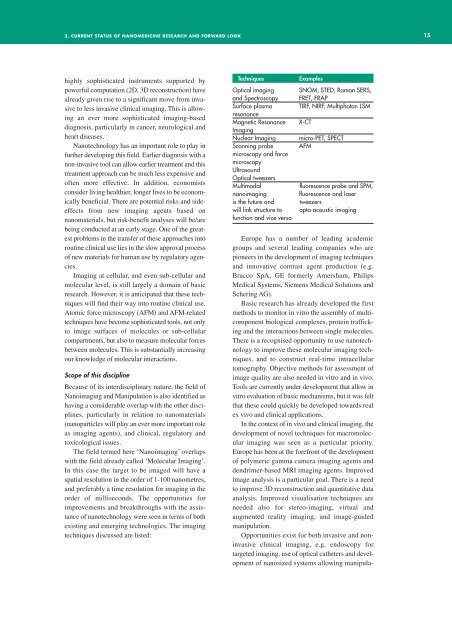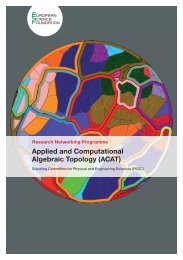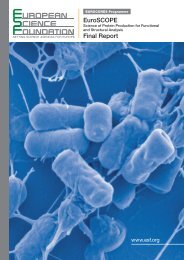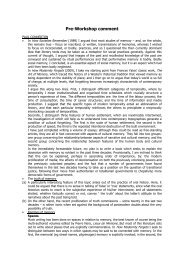Nanomedicine - European Science Foundation
Nanomedicine - European Science Foundation
Nanomedicine - European Science Foundation
You also want an ePaper? Increase the reach of your titles
YUMPU automatically turns print PDFs into web optimized ePapers that Google loves.
2. CURRENT STATUS OF NANOMEDICINE RESEARCH AND FORWARD LOOK 15<br />
highly sophisticated instruments supported by<br />
powerful computation (2D, 3D reconstruction) have<br />
already given rise to a significant move from invasive<br />
to less invasive clinical imaging. This is allowing<br />
an ever more sophisticated imaging-based<br />
diagnosis, particularly in cancer, neurological and<br />
heart diseases.<br />
Nanotechnology has an important role to play in<br />
further developing this field. Earlier diagnosis with a<br />
non-invasive tool can allow earlier treatment and this<br />
treatment approach can be much less expensive and<br />
often more effective. In addition, economists<br />
consider living healthier, longer lives to be economically<br />
beneficial. There are potential risks and sideeffects<br />
from new imaging agents based on<br />
nanomaterials, but risk-benefit analyses will be/are<br />
being conducted at an early stage. One of the greatest<br />
problems in the transfer of these approaches into<br />
routine clinical use lies in the slow approval process<br />
of new materials for human use by regulatory agencies.<br />
Imaging at cellular, and even sub-cellular and<br />
molecular level, is still largely a domain of basic<br />
research. However, it is anticipated that these techniques<br />
will find their way into routine clinical use.<br />
Atomic force microscopy (AFM) and AFM-related<br />
techniques have become sophisticated tools, not only<br />
to image surfaces of molecules or sub-cellular<br />
compartments, but also to measure molecular forces<br />
between molecules. This is substantially increasing<br />
our knowledge of molecular interactions.<br />
Scope of this discipline<br />
Because of its interdisciplinary nature, the field of<br />
Nanoimaging and Manipulation is also identified as<br />
having a considerable overlap with the other disciplines,<br />
particularly in relation to nanomaterials<br />
(nanoparticles will play an ever more important role<br />
as imaging agents), and clinical, regulatory and<br />
toxicological issues.<br />
The field termed here ‘Nanoimaging’ overlaps<br />
with the field already called ‘Molecular Imaging’.<br />
In this case the target to be imaged will have a<br />
spatial resolution in the order of 1-100 nanometres,<br />
and preferably a time resolution for imaging in the<br />
order of milliseconds. The opportunities for<br />
improvements and breakthroughs with the assistance<br />
of nanotechnology were seen in terms of both<br />
existing and emerging technologies. The imaging<br />
techniques discussed are listed:<br />
Techniques<br />
Optical imaging<br />
and Spectroscopy<br />
Surface plasma<br />
resonance<br />
Magnetic Resonance<br />
Imaging<br />
Nuclear Imaging<br />
Scanning probe<br />
microscopy and force<br />
microscopy<br />
Ultrasound<br />
Optical tweezers<br />
Multimodal<br />
nanoimaging<br />
is the future and<br />
will link structure to<br />
function and vice versa<br />
Examples<br />
SNOM, STED, Raman SERS,<br />
FRET, FRAP<br />
TIRF, NIRF, Multiphoton LSM<br />
X-CT<br />
micro-PET, SPECT<br />
AFM<br />
fluorescence probe and SPM,<br />
fluorescence and laser<br />
tweezers<br />
opto-acoustic imaging<br />
Europe has a number of leading academic<br />
groups and several leading companies who are<br />
pioneers in the development of imaging techniques<br />
and innovative contrast agent production (e.g.<br />
Bracco SpA, GE formerly Amersham, Philips<br />
Medical Systems, Siemens Medical Solutions and<br />
Schering AG).<br />
Basic research has already developed the first<br />
methods to monitor in vitro the assembly of multicomponent<br />
biological complexes, protein trafficking<br />
and the interactions between single molecules.<br />
There is a recognised opportunity to use nanotechnology<br />
to improve these molecular imaging techniques,<br />
and to construct real-time intracellular<br />
tomography. Objective methods for assessment of<br />
image quality are also needed in vitro and in vivo.<br />
Tools are currently under development that allow in<br />
vitro evaluation of basic mechanisms, but it was felt<br />
that these could quickly be developed towards real<br />
ex vivo and clinical applications.<br />
In the context of in vivo and clinical imaging, the<br />
development of novel techniques for macromolecular<br />
imaging was seen as a particular priority.<br />
Europe has been at the forefront of the development<br />
of polymeric gamma camera imaging agents and<br />
dendrimer-based MRI imaging agents. Improved<br />
image analysis is a particular goal. There is a need<br />
to improve 3D reconstruction and quantitative data<br />
analysis. Improved visualisation techniques are<br />
needed also for stereo-imaging, virtual and<br />
augmented reality imaging, and image-guided<br />
manipulation.<br />
Opportunities exist for both invasive and noninvasive<br />
clinical imaging, e.g. endoscopy for<br />
targeted imaging, use of optical catheters and development<br />
of nanosized systems allowing manipula-

















